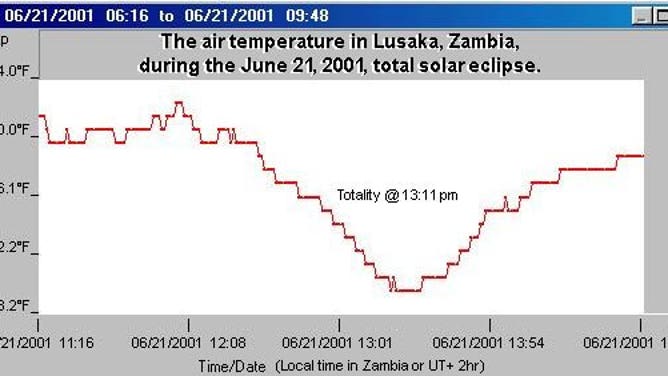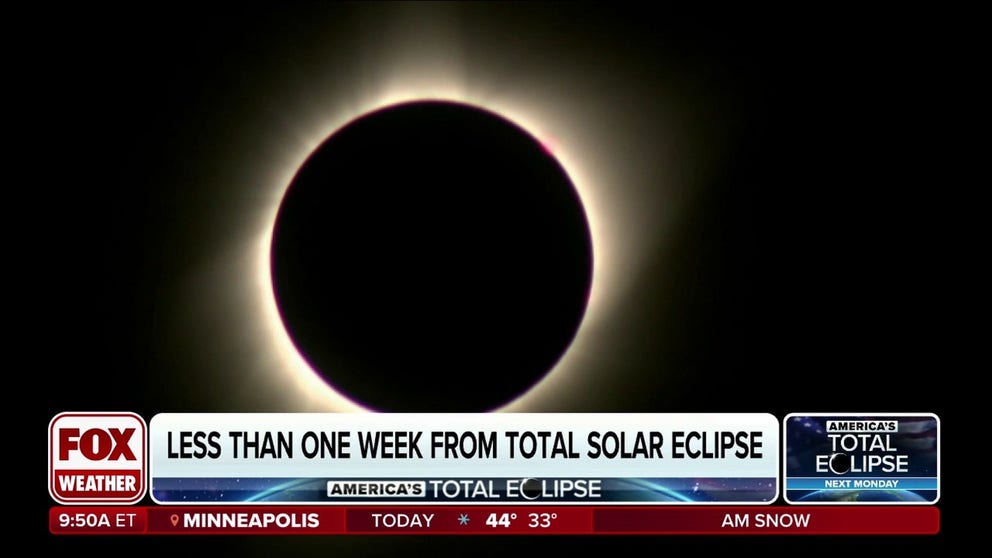How a total solar eclipse will affect the weather
In the U.S., communities from Texas to Maine are gearing up for the event on April 8th. More than 30 million Americans are estimated to live in the path of totality, with millions more expected to travel to the 15 states where the event will be visible.
Countdown to first total solar eclipse since 2017 is underway
Space experts say they feel like a kid in the run-up before Christmas with the total solar eclipse less than a week away.
A total solar eclipse that will begin over the Pacific and travel over Mexico, the U.S. and Canada on April 8th will do more than impact sunlight. Changes in the weather will also be experienced in and around the path of totality.
A total solar eclipse occurs when the Moon travels between Earth and the Sun, blocking out sunlight and allowing its shadow to project on the globe.
The temporary darkness only lasts a few minutes, but its impact on temperatures, winds and even cloud cover can last much longer.
Eclipses experienced in the U.S. during 2017 and 1979 have given experts a sense of what to expect Monday.
MISS THE APRIL 8 TOTAL SOLAR ECLIPSE? HERE’S A LIST OF FUTURE CELESTIAL EVENTS

This graphic shows the best cities in the path of totality during the total solar eclipse on April 8, 2024.
(FOX Weather)
Impacts on the thermometer
Since North America is not in summer, the swings in temperatures caused by the eclipse will be lesser than if the event were to occur in July or August.
During the eclipse in August 2017, widespread areas of the country experienced a temporary temperature drop of between 3 and 6 degrees, with some observational sites reporting a dip of more than 10 degrees.
Temperatures quickly rebounded once the event was over, but the fluctuations were noticeable in areas where lower humidity existed.
The Gettysburg Republican Banner reported the greatest known temperature drop from a total solar eclipse on Dec. 9, 1834.
The newspaper said that the temperature in southern Pennsylvania dropped from an unusually warm 78 degrees to 50 degrees – a whopping 28-degree plummet in just a few minutes.
FAA WARNS OF IMPACTS TO AIR TRAVEL DURING SOLAR ECLIPSE

The change in air temperature during a 2001 eclipse over Lusaka, Zambia.
(NASA)
Winds trail off
An English astronomer and mathematician, who might be remembered more for a notorious comet than weather fluctuations during an eclipse, noted the changes in wind during an event in 1715.
Edmond Halley noted a shift in the wind direction as the Moon temporarily blocked out the Sun.
Further studies over the decades by scientists at the United Kingdom’s University of Reading found that wind speed drops and changes in direction were connected to total solar eclipses.
"As the sun disappears behind the Moon the ground suddenly cools, just like at sunset. This means warm air stops rising from the ground, causing a drop in wind speed and a shift in its direction, as the slowing of the air by the Earth’s surface changes," Giles Harrison, a professor at the University of Reading, previously stated.
Those being impacted by significant wind events, such as a gale-force storm during an eclipse, likely wouldn’t detect a reduction in wind speeds, but residents in a normal weather pattern might.
NASA TO LAUNCH ROCKETS INTO MOON’S SHADOW DURING GREAT NORTH AMERICAN ECLIPSE
Noticeable decrease in cloud cover
Previous eclipses have shown a tendency to diminish cloud cover when as little as 15% of the Sun is covered.
In a study recently published in the journal Nature, scientists examined eclipses that occurred from 2005 to 2016 and found cumulus clouds were usually the first to disappear.
These clouds are usually low-level, fair-weather indicators that appear puffy. They do not lead to a significant blockage of the Sun.
A pending eclipse doesn’t mean all clouds will clear. Those socked in with nimbostratus (overcast) or even cumulonimbus (thunderhead) clouds will likely miss seeing the celestial event.
Near the end of an eclipse, the atmosphere goes back to its status quo without any known lingering impacts in the lower regions of the atmosphere.
